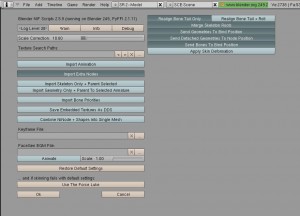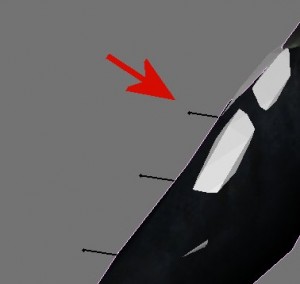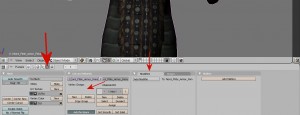I left off last time by finally importing the nordcuirassf_0.nif into Blender.
Don’t forget to delete the default Blender cube, first.
Importing the Nif into Blender
You do this under File>Import>NetImmerse/Gamebryo. There’s a whole bunch of scary looking settings that pop up, but just hitting OK works. Unfortunately, it created difficulty with the next step. Each time I imported it, there was no skeleton to select or at least I thought so. Hmm. I played around with the import options for a bit, and not really getting anywhere, and it was now six hours from when I started. This was taking way too long. I took a look around in more advanced tutorials to realize that the tutorial I had been using had outdated settings compared to the version of Blender I was using. Time to start again. I went out to check other tutorials, came back and reconfigured the import.
There were several new options in the version of Blender I was using, 2.49b, and some of the tutorials were made with the earlier versions. These are the settings you’ll need:
If you’re looking at this from the future, it may look different for you. WoooOooOoo!
A good tutorial
I’m thanking my lucky stars because, seriously, it was about time. The one thing I dislike about having to go through tutorial after tutorial is sometimes they skip or touch on really important steps like they expect you to know it. It’s maddening.
Anyway, there is my steel plate armor, in all its boob-plate glory. The tutorial, like others, says to delete the skeleton. Interesting.
Right click the skeleton until it turns pink, and press delete and select OK. Then select the object and hit alt+p, and “clear parent.”
Next, you need to delete the armature and the vertex groups.
You’ll need to select the object (right click on it, it’ll have a pink outline) and make sure you’re in the correct panel, where the large red arrow is pointing. The two smaller arrows show where the armature and vertex groups will be found. For armature, click the X button next to where it says armature. For vertex groups, hit delete. You should be done when it looks like the picture above. If you’re confused, the tutorial linked above also has photos. I was ready to start editing, for the most part.
Adding the Texture
When I came to step 6 on that tutorial, it showed their thief armor covered in the texture. I was changing some of the basic structure of this armor, and having the texture on it so I could see how it was affecting the UV map is useful. You can see above I finally figured out how to do it, but at first I was frustrated. I hadn’t touched Blender in a long time (and it was different version) and sometimes the ways you do things changes slightly on different Blender releases.
To add the texture to your model, you first must have extracted it from the texture bsa. It should be found in the same kind of folder structure as in meshes. I copied everything with the nordcuirassf.dds, nordcuirassf_m.dds and nordcuirassf_n.dds into my project folder.
Now, I’m assuming you know how to use Blender at least somewhat. If you don’t, there are literally thousands of Blender tutorials out there for you to use. However, the only thing we really want to deal with is the UV mapping. Here’s a video tutorial that nicely covers it, though Mr. Krakow goes a little fast and you may have to listen to it a few times.
The important thing you need to know is to make sure all of the vertices in the armor is selected (check in the editing mode,) then open a new view window, set it to the UV map, click image, and open. I selected my nordcuirassf.dds in my working folder, because the others deal with the normals.
Finally, I was ready to move those vertices around!



